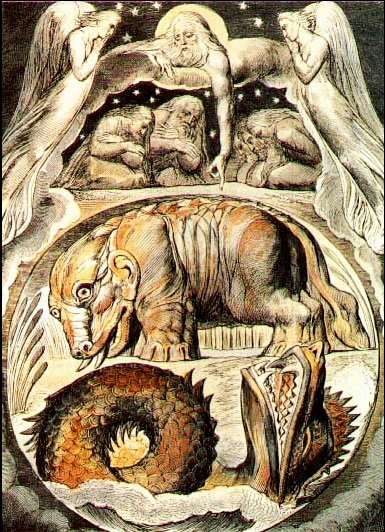Within the epoch tale of Job in the Old Testament, there is a cryptid creature which hides among the reeds and under the lotus flowers of a marsh (Job 40:15-24).
Biblical scholars have long debated the identity of this untamable animal with its massive and powerful body that can submerge itself under the water lilies and conceal itself under the shadows of the lotuses.
No man can capture this “behemoth” with its tail that swings like a tree and its legs that are like rods of iron.

Job 40:21-22 reads: Under the lotus plants it lies, hidden among the reeds in the marsh. The lotuses conceal it in their shadow; the poplars by the stream surround it.
While the lotus plant has a preeminent place in the symbolism of many eastern religions, could there also be a spiritual significance to this singular reference to the sacred flower in the biblical narrative?
What does the bible actually say about lotus flowers?
what does the Lotus flower mean in Christianity?
And finally what is its spiritual significance and symbolism? Let us find out today..
Lotus flower in Christianity vs Other cultures:
For many Asian and Indian cultures, the aquatic flowers of the lotus plant are a prominent icon in the religions of Hinduism, Buddhism, Sikhism, and Jainism.
As the national plant of India, the lotus or “Padma” is also known as the Bean of India, the Indian Lotus, and the Sacred Lotus. Within many of the sacred texts of the religions of Buddhism and Hinduism, the Padma symbolizes the emergence of life and purity in the same way that the lotus is able to rise above the muddy pond or marsh as a beautiful flower. The Brahma (god of creation) in Hinduism is believed to be born out of the bud of a lotus, which represents the birth of the spiritual consciousness.
Likewise, in Buddhism, the Buddha is often depicted as sitting on a lotus plant as one who has risen above the murky waters of chaos to enlightenment. Even ancient Egyptian hieroglyphs use the lotus to symbolize the belief in the rebirth of life after death.
Therefore, in many ancient belief systems, the lotus represents the ideas of creation, spiritual cleansing or enlightenment, and even the resurrection of life. The Bible, however, only has this one isolated reference in the Book of Job to the lotus; which would seem to indicate at least on the surface, that the lotus flower does not have the same spiritual significance within the religion of Christianity.

Although, Christian churches in India often display an empty cross sitting on a lotus flower known as the Cross of Saint Thomas. Tradition claims that Thomas the disciple shared the good news of Jesus’ resurrection with the people of Asia; and this cross reflects the rise of Christianity in India.
So with only one isolated reference in Bible, How can one know the actual spiritual meaning of the Lotus flower?
Just as the behemoth hides beneath the lotus and conceals itself in the shadows, there may possibly be some hidden spiritual connections that can be made between the sacred flower of the lotus and the risen Savior of Christianity.
Before considering these possible connections, it should first be noted that followers of Christianity do not assign mystical powers to the natural world; and therefore Christians do not believe that the lotus innately contains any divine properties.
The Bible forbids elevating the created things of this world above or even equal to the Creator (See Deuteronomy 4:15-19 and Romans 1:25). Objects of nature are not inherently sacred, but rather it is the purpose for which the object is used that makes it holy or set apart as spiritual instruments and symbols of worship (See Matthew 23:16-22). Instead, the Bible claims that the material elements of this world point to and reveal to us various aspects of God’s divine nature.
Romans 1:20 declares, “For since the creation of the world God’s invisible qualities—his eternal power and divine nature—have been clearly seen, being understood from what has been made, so that people are without excuse.”
So, what is God revealing to us about Himself when he describes this creature that lies beneath the lotus in the Book of Job? The verses of the entire story are written in a poetic style filled with symbolism pointing the reader to consider God’s divine solutions to life’s daily struggles.
Therefore, we must consider the identity of this cryptid with its insatiable appetite and its brutish persona. He is ravenous and unfazed by other creatures or the raging currents of his surroundings. Nothing can tame, control, or contain him, but God alone. Perhaps, God was revealing to Job the sinful heart of mankind which becomes animalistic in its nature, uncontrollable and unsatisfied.
Sinful people are often monstrous at heart. Mankind is incapable of taming this beast that hides in the muddy mire of sin, but God can. In the same way that the lotus flower can hide the behemoth, the Lily of the Valley (Jesus) hides our massive beast-like body of sin. He covers us in the shadows of the cross and His love.
Like the Padma, which has the ability to remove toxins from the water without contaminating its own system, Jesus also purifies our imperfections and impurities.

Another connection between the lotus and Jesus is the fact that a lotus seed can live for over a thousand years and even has the ability to be “resurrected” after a period of lying in stasis. It is also interesting to consider that the roots of the lotus plant can reach a depth of six feet below the surface of the water, which is coincidently the standard depth of most graves. The bulb of the lotus flower raises up out of the watery grave over the course of three days before it blooms, which is a perfect parallel to the resurrection of Jesus three days after His crucifixion.
So, while it is not explicitly stated in the Bible, the lotus plant does point us to the resurrected Savior of Christianity. As Job responded to the image of the behemoth beneath the lotus, we should respond to the presence of Jesus who can cleanse us from our sins and give us eternal life: “My ears had heard of You, but now my eyes have seen You. Therefore I despise myself and repent in dust and ashes” (Job 42:5-6).
Note: Unless otherwise specified, all Bible references in this article are to the Holy Bible: New International Version, (Biblica, Inc., 2011).
Dr. Richard Sams is a top Biblical and Religious educator, who holds a Doctor of Ministry degree (Evangelism and Church Growth emphasis) from the Southern Baptist Theological Seminary in Louisville. He has two masters’ degrees (Master of Divinity and Master of the Arts of Religion) from Liberty Baptist Theological Seminary in Lynchburg and also serves on the Pastoral Leadership Advisory Board of Liberty University. Moreover, Richard Sams has been serving as a pastor (Pastoral Ministry) at Calhoun Baptist Church in Calhoun, KY, from the past Nineteen years. He loves practically imparting biblical truths to the next generation, while occasionally conduct spiritual challenges on his facebook page facebook.com/MakeItCountChallenge
